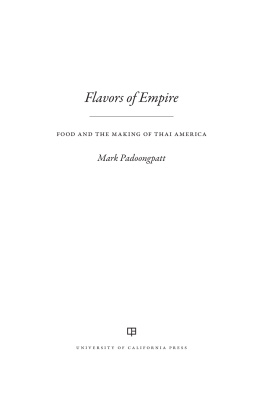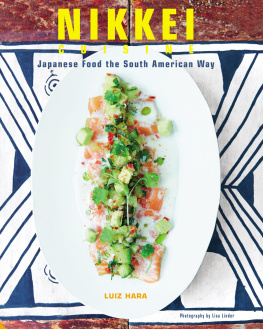FOOD CULTURES OF THE UNITED STATES
Recipes, Customs, and Issues
Bruce Kraig
The Global Kitchen

Copyright 2020 by ABC-CLIO, LLC
All rights reserved. No part of this publication may be reproduced, stored in a retrieval system, or transmitted, in any form or by any means, electronic, mechanical, photocopying, recording, or otherwise, except for the inclusion of brief quotations in a review, without prior permission in writing from the publisher.
Library of Congress Cataloging-in-Publication Data
Names: Kraig, Bruce, author.
Title: Food cultures of the United States : recipes, customs, and issues / Bruce Kraig.
Description: Santa Barbara, California : Greenwood, an Imprint of ABC-CLIO, LLC, [2020] | Includes bibliographical references and index.
Identifiers: LCCN 2019041067 (print) | LCCN 2019041068 (ebook) | ISBN 9781440866586 (hardback) | ISBN 9781440866593 (ebook)
Subjects: LCSH: Food habitsUnited States. | Food preferencesUnited States.
Classification: LCC GT2853.U6 K73 2020 (print) | LCC GT2853.U6 (ebook) | DDC 394.1/20973dc23
LC record available at https://lccn.loc.gov/2019041067
LC ebook record available at https://lccn.loc.gov/2019041068
ISBN: 978-1-4408-6658-6 (print)
978-1-4408-6659-3 (ebook)
24 23 22 21 20 1 2 3 4 5
This book is also available as an eBook.
Greenwood
An Imprint of ABC-CLIO, LLC
ABC-CLIO, LLC
147 Castilian Drive
Santa Barbara, California 93117
www.abc-clio.com
This book is printed on acid-free paper 
Manufactured in the United States of America
The publisher has done its best to make sure the instructions and/or recipes in this book are correct. However, users should apply judgment and experience when preparing recipes, especially parents and teachers working with young people. The publisher accepts no responsibility for the outcome of any recipe included in this volume and assumes no liability for, and is released by readers from, any injury or damage resulting from the strict adherence to, or deviation from, the directions and/or recipes herein. The publisher is not responsible for any readers specific health or allergy needs that may require medical supervision, nor for any adverse reactions to the recipes contained in this book. All yields are approximations.
Contents
Series Foreword
Imagine a typical American breakfast: bacon, eggs, toast, and home fries from the local diner. Or maybe a protein-packed smoothie, sipped on the go to class or work. In some countries in Europe, breakfast might just be a small cookie and a strong coffee, if anything at all. A South African breakfast might consist of a bowl of corn porridge with milk. In Japan, breakfast might look more like dinner, complete with rice, vegetables, and fish. What we eat varies from country to country, and even region to region. The Global Kitchen series explores the cuisines of different cultures around the world, from the history of food and food staples to main dishes and contemporary issues. Teeming with recipes to try at home, these volumes will delight readers by discovering other cultures through the lens of a treasured topic: food.
Each volume focuses on the culinary heritage of one country or one small group of countries, covering history and contemporary culture. Volumes begin with a chronology of major food-related milestones and events in the area, from prehistory to present. Chapters explore the key foods and meals in the country, covering the following topics:
- Food History;
- Influential Ingredients;
- Appetizers and Side Dishes;
- Main Dishes;
- Desserts;
- Beverages;
- Holidays and Special Occasions;
- Street Food and Snacks;
- Dining Out; and
- Food Issues and Dietary Concerns.
Chapters are textual, and each chapter is accompanied by numerous recipes, adding a hands-on component to the series. Sidebars, a glossary of important terms, and a selected bibliography round out each volume, providing readers with additional information and resources for their personal and scholarly research needs.
Whether readers are looking for recipes to use for classes or at home, or to explore the histories and traditions of world cuisines, the Global Kitchen series will allow readers to fully immerse themselves in other cultures, giving a taste of typical daily life and tradition.
Introduction
Every day, multiple times, almost all Americans think about food. What to eat, when to eat, and where to get food is so deeply embedded in American peoples existence that they scarcely realize that they are thinking about it. A lot of ordinary conversation is about food in all of its aspects, from eating out to discussions about recipes. Meal planningincluding reading cookbooks and watching television cooking showsshopping, food preparation, and actual eating take up hours of almost everyones day. Of all biological functions, eating and what follows from it, are the ones with the most culture around them. From personal and group identification to taboos and taste and distaste, jokes, stories, movies, television programs, and much more, food is central to peoples lives. And yet Americans usually take all these for granted as normal behaviors in everyday life.
Different peoples around the world have not eaten in the same ways as everyone else, though today, international contacts have made those differences smaller. Nonetheless, America is unique in many ways. Those who study foodways (meaning the economic, social, and cultural habits of a people) ask why do Americans eat what they eat? Where does the food come from and why do they like it, or not like it? Why do they dine at certain times of the day and what rituals do Americans use for eating, such as using forks or eating out of hand?
American food, what is eaten and what is not, comes mostly from immigrant origins. Cattle (beef and dairy products made from cows milk), pork from pigs, chickens, sheep (lamb), and goats (mostly dairy), wheat, barley, rye, oats, rice, apples, peaches, watermelons, pears, broccoli, spinach, chard, kale, and many others, are imports from the Old World (Europe, Africa, and Asia). Of the relatively few plants native to North America that we eat, corn is the most important. Animal feeds, corn oil, corn meal, corn starch, corn syrup, high fructose corn syrup, and sweetened and plain popcorn, this seed is in about 60 percent of American food. Beans are next, followed to much lesser extents by squash and pumpkins as native foods seen regularly on American tables. What is eaten at meals to this day is really based on European, specifically British and German, tastes: meat, potatoes, bread, some vegetables, and sweets at the end.
How American food is produced, processed, and sold has changed over time. Most of the changes have come from the demand for quantity, convenience, and cheaper foods. From the Colonial period well into the nineteenth century, most food came from small family farms. Farmers fed themselves and the rural communities in which they lived, while city people got food mostly from local farms in the vicinity. With the rise of large-scale farming and meat production, food could be produced in one part of the nation and shipped everywhere. At first, this was by canal boats and railroads and, from the mid-twentieth century onward, by trucks using the interstate highway system. With large-scale farming came new food processing and preservation technologies. Meat could be packed in central locations and shipped in refrigerated railway cars and trucks everywhere: the packaged meats in grocers cases today are ready for cooking or, if preserved, eaten immediately. Almost any food was canned from the Civil War period onward. Canned vegetables, meats, soups, milk, and sweets filled grocery store shelves giving families convenient ways to prepare meals at low prices. After World War II, there was a frozen food boom as home freezers became widespread. Today, almost every food imaginable can be found in frozen food cases, from fish to meats, vegetables, prepared meals, pizzas, many snacks, and plenty of cakes and ice creams. To cook them, new devices such as the microwave oven were devised and are now standard in almost every home kitchen. Toasters and toaster ovens, slow cookers, pressure cookers, air fryers, and many more cooking tools came on the market to make breakfast, lunches, dinners, and snacks quickly and easily. Just as machines were invented to prepare new foods, companies that process foods adapted their products to new apparatuses. For example, fruit-filled tarts and pies could be cooked in toasters and breakfast cereals cooked in their packages in microwave ovens. Cookery publications, in print and online, boast of how swiftly meals can be prepared, completely unlike cookery in centuries past when nothing was convenient and women spent long hours raising food in gardens and preparing meals.
Next page








